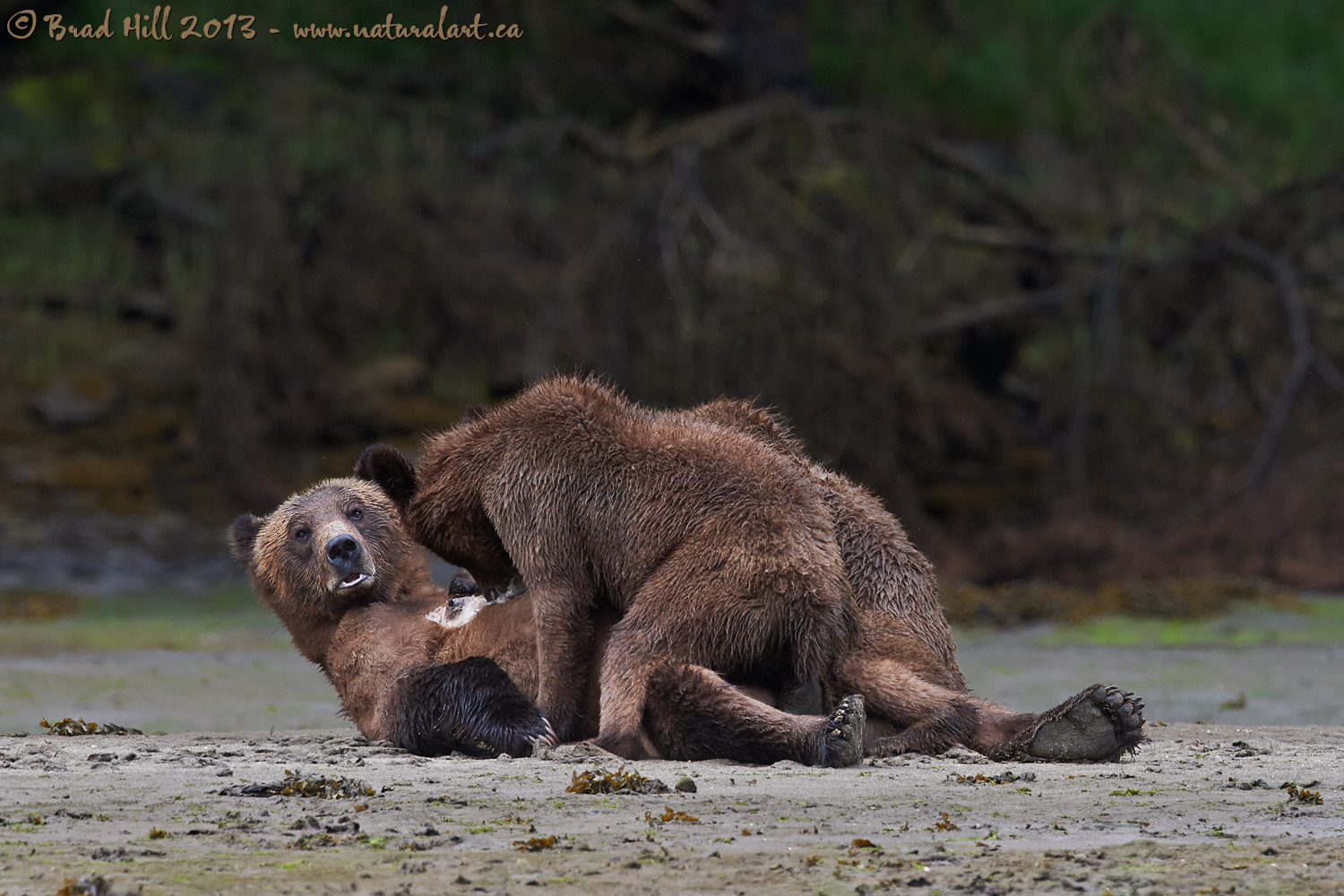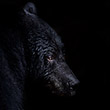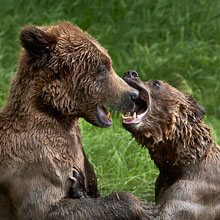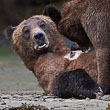Availability: Undetermined - Enquiries?
In the Field
Don't Cry Over Spilt Milk! Khutzeymateen Grizzly Sanctuary, Great Bear Rainforest (northern BC coast). June 1, 2013.
No need to cry over spilt milk - even Ma isn't too worried that her two cubs are being a little sloppy as they nurse on an exposed sand bar in the Khutzeymateen estuary!
This female grizzly has to rank high in the animal kingdom's "world's best mom" competition. She's ever-vigilant and her two cubs - now in their 3rd spring - seem as healthy as can be (despite the fact that they're living in an area literally crawling with large and hungry male bears!). This was a real special moment - we had seen ma nursing her cubs many times before, but she always took them into the surrounding forest and all we got were quick glimpses between the leaves and branches. But this time, Ma just walked to a high spot on a sand bar and, in plain view, laid down and let the cubs dog-pile on top of her and begin suckling away! And, as is visible in this photo, the cubs were pretty unconcerned about how much of a "mess" they made on Ma's chest! I suspect she did feel just a tad exposed (so to speak) - she made a point of looking up every few moments as though she was checking that we were behaving ourselves and keeping a respectful distance!
This fantastic photo op presented itself when I had a Nikkor 500mm f4 VR lens mounted on my D4 body (yep, darned lucky). I don't own a 500mm f4 (it was a friend's lens and he lent it to me while he tried out my 400mm f2.8 VR) but a few years back I borrowed one from Nikon to test and compare it to my own 400mm f2.8 VR and 600mm f4 VR. My impression "way back then" was that it was somewhat easier to hand-hold than its significantly heavier relatives (the 400mm f2.8 VR and the 600mm f4 VR). Since that time I have shot both of the big monsters hand-held a lot and have gotten quite used to it. And, when I picked up the 500mm f4 this time, it felt like a lightweight lens (hey - everything is relative)! I have to say I really enjoyed shooting the 500mm f4 and I can fully understand why many photographers opt for the 500, especially if they might be forced to hand-hold their super-telephoto lenses.
Does this mean I'm considering selling either or both of my other big lenses and replacing them with a 500mm f4 VR? Nope. I love the speed, sharpness and contrast of my 400mm f2.8 VR and consider it my #1 "go-to" wildlife lens. And, when the opportunity is right (meaning I need more reach than my 400 provides), I just love what the 600mm f4 VR can do (even hand-held). But I AM splitting hairs - to be honest you can't go wrong with ANY of the Nikon's "big three"...and most shooters would likely get the most mileage and use out of the 500, largely owing to its noticeably lighter weight and ease of handling. It's not impossible I will add a 500mm f4 to my "stable" of lenses sometime in the future.
Here's a higher resolution (2400 pixel) version of the shot for those wanting to see more detail:
• Don't Cry Over Spilt Milk! Download 2400 pixel image (JPEG: 1.1 MB)
ADDITIONAL NOTES:
1. This image - in all resolutions - is protected by copyright. I'm fine with personal uses of them (including use as desktop backgrounds or screensavers on your own computer), but unauthorized commercial use of the image is prohibited by law. Thanks in advance for respecting my copyright!
2. This image was captured during one of my two spring "Grizzlies of the Khutzeymateen" photo tours in May/June of 2013. Each year I offer trips into two different parts of the Great Bear Rainforest as well as one to photograph aquatic mammals and oceanscapes near the northern tip of Vancouver Island. And, in selected years, I also offer photo tours to locations to capture other highly sought-after subjects, such as various boreal owl species and wildlife of Canada's Arctic. Details about these trips can be found on the Photo Tours page of this website.
3. Like all wildlife photographs on this website, this image was captured following the strict ethical guidelines described in The Wildlife FIRST! Principles of Photographer Conduct. I encourage all wildlife photographers to always put the welfare of their subjects above the value of their photographs.
Behind the Camera
Don't Cry Over Spilt Milk! Khutzeymateen Grizzly Sanctuary, Great Bear Rainforest (northern BC coast). June 1, 2013.
Digital Capture; Compressed RAW (NEF) 14-bit format; ISO 1000.
Nikon D4 paired with Nikkor 500mm f4 VRII prime lens - hand-held from floating Zodiac. VR on and in normal mode.
1/500s @ f8; -0.33 stop compensation from matrix-metered exposure setting.
At the Computer
Don't Cry Over Spilt Milk! Khutzeymateen Grizzly Sanctuary, Great Bear Rainforest (northern BC coast). June 1, 2013.
RAW Conversion to 16-bit TIFF, including first-pass/capture sharpening using Capture One Pro version 7. Two raw variants (images processed from raw) differing by a total of 0.4 stops in total exposure.
Further digital corrections on resulting 16-bit TIFF files using Adobe's Photoshop CS6 and Light Craft's Lightzone. Photoshop adjustments included compositing the raw conversion exposure variants, selective minor tweaks to exposure and contrast (using selective curves adjustment), and selective sharpening for web output. Final tone tweaking performed using tonemapper/re-light tool in Lightzone.
Conservation
Don't Cry Over Spilt Milk! Khutzeymateen Grizzly Sanctuary, Great Bear Rainforest (northern BC coast). June 1, 2013.
Ten percent of the revenue generated by this image will be donated to Raincoast*.
Species Status in Canada**: Special Concern (May 2002).
While Grizzly Bears (Ursus arctos) are not technically listed as "Endangered" in Canada, they have been extirpated from most of their historical range. Grizzly Bears are far more sensitive to intrusion/disturbance in their habitat than are Black Bears and are being increasingly forced into marginal habitat by human encroachment. The Great Bear Rainforest along the central and northern coast of British Columbia is one of the last strongholds of the Grizzly Bear in Canada, and even this population is coming under increasing pressure.
On December 18, 2017 the government of British Columbia banned grizzly hunting across the entire province. This major conservation victory came after decades of tireless work by many dedicated conservationists and ecologists and, most importantly, it reflects the opinion of the vast majority of British Columbians. And, it means that AT LEAST while the current government remains in power grizzlies are finally "safe" in British Columbia.
Now that we've at least temporarily won the battle to save grizzlies in BC, it's time to re-focus our efforts toward protecting ALL of BC's carnivores, including Gray Wolves, Black Bears, Cougars, Wolverines, and more! Simply put, there are no ecological, economic, or ethical arguments supporting the trophy hunting of carnivores.
In a great first step towards ending the hunting of carnivores throughout BC the Raincoast Conservation Foundation has developed a program designed to protect ALL carnivores within the Great Bear Rainforest. Details about this program can be found on this page on Raincoast's website. Check it out and, better yet, make a donation to help Raincoast purchase the remaining commercial hunting tenures in the Great Bear!
*The Raincoast Conservation Society (and Foundation) is an effective and efficient organization that has been fighting for protection of this unique habitat. If you are looking for a meaningful way to contribute to the conservation of this amazing ecosystem, Raincoast will provide maximal "bang" for your conservation dollars.
**as determined by COSEWIC: The Committee on the Status of Endangered Wildlife in Canada

























